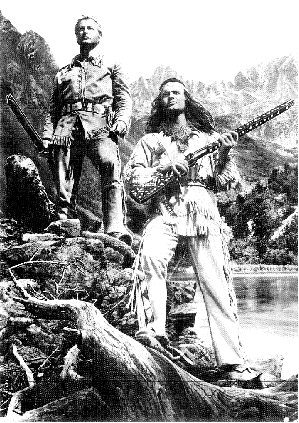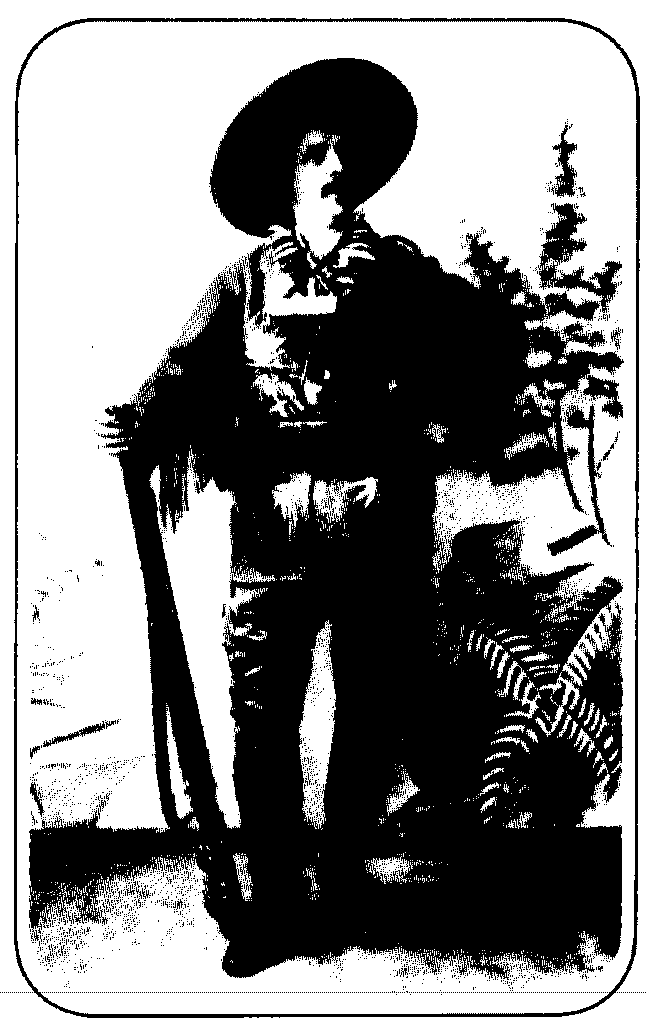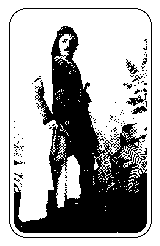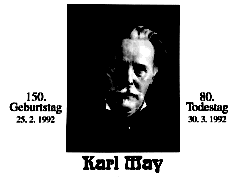The Alluring Myth of the Desert:
European Fascination with the Llano Estacado*

Llano Estacado: The Land
The land was first. A flat, isolated plateau: 32,000 square miles of prairie. In length, the land is 250 miles from the breaks of the Canadian River on the north to the dusty chaparral of the Permian Basin to the south; in width, 150 miles east and west. The land is crowned to the north, east and west by a Caprock escarpment that separates the plateau from the surrounding lowlands.
The land is the Llano Estacado or Staked Plains. It is a contiguous physiographic province, a mesa or tableland remnant from the apron of outwash that stretched eastward following uplift of the Rocky Mountains 65 million years ago. Early American explorers labeled the land a portion of the Great American Desert and predicted it would remain forever uninhabited.
The arid Llano Estacado can be a foreboding place. The climate varies among extremes and includes frequent, recurring cycles of drought. Relentless spring winds abrase the soil and, when the climate turns dry, extend to summer. Sudden, severe storms in spring and summer bring torrential downpours, hail, and occasional tornadoes.
But the land contains extremes of beauty as well: incredible sunsets; an exhilarating summer climate; a bountiful resource base in the soil. This is the land of the Llano Estacado.
From the Texas Tech University exhibit: The Llano Estacado Experience: Utilization of the Arid Lands of
Texas.
There, where the Southeast edge of New Mexico juts into the region of Texas, lies one of the most dangerous corners of the distant West. It is there that the adjacent territories of the Comanches and Apaches touch, a situation which has as its natural consequence the continuous insecurity of the area.
``The shears,'' as the Frontiersman calls this dangerous place, is a very fitting name. The boundary lines are mobile; they open and close like shearing blades, and anyone who comes between them may speak of great luck to escape with his skin intact. A white man who lets himself be seen there is either extremely brave or very careless; in both cases the ``vulture of death'' circles endlessly over his head.
There, where the Toya river emerges from the Devil's Mountains and flows into the Rio Pecos, the latter shaped in those days the border between the land of the Comanches and Apaches. Westward the terrain ascends to the Sierra Guadelupe, Sierra Pilaros and Sierra del Diablo, while in the East lie the Staked Plains - the infamous Llano estakado (May, 1888, pp. 215-216, translation mine).
It is not probable that many of the participants of the Fifth International Conference on Desert Development arriving during August of 1996 had given any thought to the dangerous legends connected with their destination: Lubbock, Texas, capital of the Llano Estacado. Without escaping from the safety of the city and from the endless uniformity of the surrounding flat fields into the remote seclusion of a canyon area, it is hard to know anything of the uniqueness of the region. Even then it takes a skilled eye and very good luck to find a trace of the native American cultures which were here continuously for over 12,000 years.
By comparison, it has been only a minute 125 years since the Comanches were defeated and forced from the Llano, but once open to settlement, changes on the Staked Plains have been steady and then rapid. Irrigation and other agricultural practices have eradicated forever the miles and miles of grasslands which supported the buffalo herds until the 1870s and which astonished immigrants to the area in the 1880s.
In 1976, the first of three major wineries opened outside Lubbock as the ``Llano Estacado Winery.'' Until recently many of the 200,000 area residents and 24,000 Texas Tech University students may not have known that Llano Estacado is the name Coronado gave the region on his trek of 1541 rather than some kind of ``red wine.'' Certainly Lubbock, founded in 1890, is one of the youngest big cities in America and the business of getting established in a harsh, semiarid climate has not often allowed residents the leisure to reflect on their own history. It was only in 1990 that a history professor at Texas Tech University, Dr. Dan Flores, published the guidebook for us all: Caprock Canyonlands: Journeys into the Heart of the Southern Plains (Flores, 1990) and now, for instance, nine years later, the evening news brings ``Weather on the Llano Estacado.''
Only those conference colleagues arriving in Lubbock who had read the German author, Karl May (1842-1912), might be wondering about the historic villains who rearranged the stakes (markers pointing to water) so as to mislead innocent pioneers on the plains and then to attack them. This story, The Spirit of the Llano Estacado, appeared in Germany in 1888 and is one of the many tales of adventure in a desert setting (May calls the Llano Estacado ``the Sahara of America'') which brought the author fame and fortune. Today in 1999, eighty-seven years after his death, it is estimated that the total circulation in German of May's adventure stories set in the Wild West and in the Near East exceeds 100 million books and his works have been translated into over 30 languages, the most recent project being a 22 volume edition in Chinese.
Early on and throughout his publishing career, Karl May used desert settings for his Near Eastern fictions. These stories have been recently characterized as being tales ...
...whose authenticity can hardly be challenged, and which sparkle with unbounded wit and suspense, and show the first-person hero as a contemporary errant knight in his successful crusade against crime and wickedness among proud and haughty sheiks and cruel slave traders and cunning bandits galore. They have all the splendor of the Arabian Nights and their characters are the liveliest to be met in this field of literature (Ilmer, 1995, pp 2-3).
Even a sample listing of the German titles with their publication dates gives a brief overview of May's early and on-going interest in the arid settings: 1877 Die
Rose von Kahira: Eine morgenländische Erzählung; 1878 Die Gum: Ein Abenteuer aus der
Sahara and Die Rose von Sokna; 1881 Ein Wüstenraub: Ein Abenteuer aus der
Sahara; 1882 In Damaskus und Baalbeck; 1885 Die Wüstenräuber: Erlebnisse einer Africa-Expedition durch die
Sahara; 1888 Durch das Land der Skipetaren; 1889 Die
Sklavenkarawanne; 1892 Durch Wüste und Harem, Durchs wilde Kurdistan, Von Bagdad nach
Stambul, and In den Schluchten des Balkan; 1893 Orangen und Datteln: Reisefrüchte aus dem
Oriente; 1896 Im Lande des Mahdi, I & II; and 1907 Durch die
Wüste.
The main character in most of the Near Eastern stories, a German called Kara Ben Nemsi (Karl, Son of the Germans), first appears in the 1880 collection of travel recollections from the realm of the Turks,
Giölgeda Padishanün, and is the fantasy figure through which Karl May projected his inspired first-person narration (Kosciuszko, 1996, p. 411). Kara Ben Nemsi reaches the zenith of his heroic action in the late work of 1907
Through the Desert. The 1936 film version of this very popular work is still shown in Germany today. The enormous success of the stories of a German moving through desert dangers has much to do with his loyal helper and constant companion/travel guide, a Bedouin named Hadschi Halef Omar Ben Hadschi Abbul Abbas Ibn Hadschi Dawud Al Gossarah, or Halef, for short. It is the friendship between Kara Ben Nemsi and Halef that intrigues and inspires the reader.
|
By 1893 May was ready to fill out the narration of another pair of loyal friends who were destined to surpass in popularity all other fictitious characters of German literature. In that year
Winnetou, the Red Gentleman appeared in volumes 1, 2, and 3. The Mescalero Apache Chief and his German friend and blood brother, Old Shatterhand, rode together over the empty Western plains from one adventure to the next and straight into the hearts of millions of readers (very often young boys or girls reading by flashlight under the covers into the night).
|

Lex Barker as Old Shatterhand and Pierre Brice as Winnetou.
Photo: Karl May Museum, Radebeul
|
In the 1960s a series of May's wild west stories were made into movies and filmed in Yugoslavia, the closest terrain to Germany which fit May's image of the Llano Estacado. It is one of the unexpected quirks of fate that cast a Frenchman named Pierre Brice in the film role of Winnetou and an American named Lex Barker (known in his own country mainly as Tarzan) in the role of Old Shatterhand. The success of this pair of actors was immediate and enormous and with it the perpetuation of Karl May's popularity into the future was solidified. In Berlin, for example, in the summer of 1996 a huge festival crowd turned out from all over Germany and from several foreign countries to celebrate the 50th anniversary of the CCC Film Studio of Artur Brauner, who filmed the Winnetou series.
In 1895 at age 53 Karl May was well on his way to being wealthy and famous. He bought a villa in Radebeul, the elegant suburb of Dresden, which he named ``Villa Shatterhand'' and which today houses the Karl May Museum. Apparently there was such a clamor from his delighted readers to see the adventurous author that May hired a photographer in 1896 to come to Villa Shatterhand and take 101 photographs of him in costumes portraying both Kara Ben Nemsi as well as Old Shatterhand. Quotes from May's texts and from letters he wrote answering questions from his fans establish his identity: ``Yes, I have experienced all that and much much more. I wear still today the scars and wounds which I received....'' ``I really visited those lands and I speak the languages of the mentioned peoples....'' ``I am in reality Old Shatterhand, respectively Kara Ben Nemsi, and have experienced what I tell....'' (Heermann 1988, p. 11, translation mine).


May posing as Old Shatterhand (left) and as Kara Ben Nemsi (right)
Who among his hundreds of thousands of adoring fans could have suspected that their literary hero not only had never been outside Europe to the places he described so thrillingly, but had researched travel books during a rather long prison term and was not adverse to lifting descriptions from other writers nor to buying his exotic costumes and travel trophies clandestinely? It was only in 1899 that May finally traveled to some of the arid lands of his dreams. His route took him to Kairo, up the Nile to Assuan and Schellal, then on to Port Said, Beirut, Haifa, Jerusalem, Suez, Aden, and finally to Ceylon and Sumatra.
However, during his absence from Germany the first reports of his past criminal history and attacks on his character appeared in the German press. During the trip he suffered psychologically as well from the confrontation with the realities of the lands he had so long imagined and so vividly idealized. Again in 1900 he made a return trip, this time with his wife and their friends, the Plöhns. But again, May suffered a nervous breakdown in Istanbul. The pressure of the personal attacks intensified.
Enormous problems in May's private life resulted in a divorce and then, shortly thereafter, marriage to widow Plöhn in 1903. From September to the beginning of December of 1908 the Mays visited the Northeastern part of America and bordering areas of Canada. There seems never to have been a plan to visit the great American West, which May had made so available to hundreds of thousands of German readers. In any event he never came. The fourth volume of Winnetou was published in 1909 and in 1912, a few days after a major lecture in Vienna, Karl May died in Radebeul.
Today in 1999, eighty-seven years after his death, the works of Karl May are selling in the book stores, are being shown in movie theaters, are scheduled for performance on at least ten summer festival stages in Germany and are hotly debated by literary experts and other members of the Karl May Society (almost 2,000 members on all continents). When Pierre Brice tried to retire from his role as Winnetou in the Bad Segeberg festival theater, the news made the front page of the New York Times. Karl May was the cover story of Der Spiegel in May of 1995. It is this on-going influence which is even more astonishing than the feats he accomplished in his lifetime.
What are the sources of appeal and power in May's works besides his great gift for story
telling?
Certainly by transporting his German readers vicariously to desert settings May does them the favor of removing them from an often damp, overcast, cold, crowded and very bureaucratically controlled Vaterland. The Llano Estacado, for example, lies longitudinally close to Morocco, in northwestern Africa, whereas Germany lies in the zones with Canada. No one who has witnessed the German exodus to the sunny South of Europe during a vacation period will question the validity of the climate as an important escape-feature of May's stories.
A comparison of the highways stretching endlessly, quietly, and quite vacantly across the Staked Plains of Texas with those bumper-to-bumper danger lanes of the German Autobahn will highlight quite nicely the basic difference in population density and resulting life style possibilities. Listen to May conjure up an alluring experience of mystical proportions on the Llano Estacado:
A nocturnal ride across the desert which stretches itself out in the moonlight! How much I wish my dear readers could feel the majestic sensations which allow the human heart to swell higher and higher. However, the heart must be free from worry and from all that could oppress and constrain it.... If only someone could give me a quill from which the right words would flow to describe the impression which such a nocturnal desert ride brings forth from a devout human heart! (May, 1894, p. 396, translation mine).
One literary question being addressed by scholars is that of the written sources used by Karl May to so convincingly portray the regions he never visited. In considering this aspect of May's Llano Estacado I came upon the forgotten name of an Irishman who in his lifetime was almost as celebrated for his wild west stories as was May. Mayne Reid (1818-1883) was actually in the American West and even up on the Llano Estacado during the period of 1840-1848. Especially interesting is Reid's two volume novel titled The Lone Ranch: A Tale of the ``Staked Plain'' and published in London in 1871. A chapter in volume 1 begins with the following detailed description of our area:
Spread before you a map of prairie-land - and I will point out the tract of territory known as the ``Llano Estacado'' or Staked Plain.
It must be a map of modern time, based on the latest explorations; else you will have some difficulty in comprehending the limits assigned to this singular, and yet almost unexplored district of country. A prairie-chart of even less than a quarter of a century ago will show it traversed by a series of parallel streams, the headwaters of the Red River of Louisiana, the Brazos of Texas - as also the numerous tributaries of the Texan Colorado. It is true that these rivers head on the Staked Plain, but none of them run across it. They have their sources within it, debouching from its eastern edge, that boldly bluffs upon the great plain of Texas by an escarpment running continuous for hundreds of miles. A strip on its eastern side is intersected by deep clefts of canons, cut by the numerous streams as they work their way to the outer and lower tableland of Texas (Reid, 1871, p. 140).
In an earlier work by Reid, The Scalp Hunters, published in 1851 and translated in Leipzig for the German market in 1852, there are numerous similarities to May's later works including a description of an Indian Chief named El Sol which is an astonishing likeness to May's beloved Winnetou (McClain, 1994).
It is interesting to note that at the time the German version came out in Leipzig, Saxony, Karl May was ten years old and living in the same German state. May was in prison twice during the period of June 1865 until May of 1874, so it is conceivable that he had access to Reid's The Scalp Hunters in German and possible that a version of Reid's The Lone Ranch made it to May's reading table.
But still the point to notice is that Mayne Reid is quite forgotten today, while Karl May's legacy reaches out from Germany to activate networks around the world. Ironically, some residents of the Staked Plains, who have not given much thought to the unique area they live in, are being influenced by Germans who come eagerly seeking the long-envisioned yet never-visited Llano Estacado of their childhood dreams. Even more impressive for locals is the fact is that the German visitors are not disappointed with what they find, not with tornado threats, not with dust storms, not with sand between their teeth nor on their food. It's all right there in Karl May's writings and Winnetou's explanations. The flat land, the huge sky, the great expanses, the shifting weather. The elements don't disappoint in this semiarid place:
Aridity, more than anything else, gives the western landscape its character. It is aridity that gives the air its special dry clarity; aridity that puts brilliance in the light and polishes and enlarges the stars; aridity that leads the grasses to evolve as bunches rather than as turf; aridity that exposes the pigmentation of raw earth and limits, almost eliminates, the color of chlorophyll; aridity that erodes the earth in cliffs and badlands rather than in softened and vegetated slopes, that has shaped the characteristically swift and mobile animals of the dry grasslands and the characteristically nocturnal life of the deserts (Stegner, 1992, p. 46).
It is entirely possible that understanding the European fascination with the Llano Estacado will allow us in Lubbock to develop in the coming years what the Germans call ein sanfter Tourismus, a gentle tourism, an educating and educated sharing of information and experiences. Slowly, over the past 15 years, there has been a movement in the entire area of the Staked Plains to prepare brochures and guide booklets in German. The Palo Duro amphitheater offers its guests from Germany a German synopsis of the ``TEXAS'' pageant prepared about 15 years ago by a Texas Tech University graduate student. Amarillo has a city tour guide printed in German. The Lubbock Lake Site has a leaflet in German. The State Department of Tourism has even produced an entire book in German advertising the many excellent travel destinations in Texas.
 Advertisement appeared in America Magazine, May/June 1997, p. 37
Advertisement appeared in America Magazine, May/June 1997, p. 37
|
In addition, the word about Lubbock is getting around in Germany, thanks to the Karl May network. An exhibit on the Llano Estacado, prepared by the Southwest Collection at Texas Tech University for the Texas Sesquicentennial in 1986, was flown to Germany in 1993 where it opened in Radebeul at the Karl May Museum. In 1996 the exhibit moved to Hohenstein-Ernstthal to the Karl May Birthplace Museum and presently it is being shown throughout the state of Saarland, thanks to the sponsorship of the German-American Institute in Saarbrücken. A new photographic exhibit on the Palo Duro has been flown over to augment the Tech production and Amarillo musicians have been on hand at some of the Saarland openings. The Lubbock Convention and Tourism Bureau has supported the move to inform Germans about the Llano Estacado and, in conjunction with the Southwest Center for German Studies, a delegation visited Berlin and Bad Segeberg in the summer of 1997. The Bureau has also started advertising Lubbock as a tourist destination for Germans.
|
And now the first German tour groups have already come and gone and once back home in the Vaterland they have written up full and glowing reports on their visit to the Llano Estacado. Each visit has been carefully honed to connect Germans with the land, to let them understand the semiarid and arid climates of Texas and New Mexico and the things they produce: ranches, canyons, adobe walls, windmills, stock tanks, prairie dogs, quarter horses, cotton, playa lakes, solar energy, and long, long, straight highways stretching out as far as you can see with nobody else in sight. The endless frontier.
It is important to notice that in the plenary addresses of the Fifth International Conference on Desert Development, tourism was listed as one of the areas of future development for arid and semiarid lands. In Lubbock, Texas, because of Texas Tech University resources such as The International Center for Arid and Semiarid Land Studies, The Ranching Heritage Center, The International Cultural Center, and The Southwest Center for German Studies, and thanks to the writings of Karl May, we are uniquely positioned to move gently and educatingly in that direction.

Photo courtesy Karl-May-Verlag, Bamberg
Footnote
* An updated and revised reprint of the article which appeared in:
Desert Development: The Endless Frontier. Proceedings of the Fifth International Conference on Desert Development, edited by Traylor, Dregne, and Mathis, Vol. II, pp. 930-937. Lubbock, Tx.: Texas Tech Press, 1999.
References
Flores, Dan. Caprock Canyonlands: Journeys into the Heart of the Southern
Plains. Austin: University of Texas Press, 1990.
Heermann, Christian. Der Mann, der Old Shatterhand war: Eine Karl-May
Biographie. Berlin: Verlag der Nation, 1988, p. 11.
Ilmer, Walther. Meet a Marvel . . . (a brochure in English printed in 1995 by the Karl May Society without information on its publication), pp. 2-3. See also:
http://www.karl-may-gesellschaft.de/kmg/sprachen/englisch/index.htm.
Kosciuszko, Bernhard, ed.
Großes Karl May Figurenlexikon. Paderborn: Igel Verlag Wissenschaft, 2. Ed. 1996,
p. 411.
May, Karl. Gesammelte Reiseromane Bd. XIV: ``Old Surehand I.'' Freiburg: Fehsenfeld Verlag, 1894, p.
396.
________. ``Der Geist des Llano estakado,'' Der Gute Kamerad. 2. Jg. (1887/88). Quoted here from the recent edition, Der Geist des Llano estakado, edited by Bernhard Kosciuszko. Stuttgart: Reclam Verlag, 1984, pp.
215-216.
McClain, Meredith. ``Karl Mays Llano estakado und die Wirklichkeit
heute,''
Jahrbuch der Karl-May-Gesellschaft 24 (1994): 299-311.
Reid, Mayne. The Lone Ranch. A Tale of the ``Staked Plain.'' London: Chapman and Hall, 1871, vol.1, p.
140.
Stegner, Wallace. Where the Bluebird Sings to the Lemonade Springs: Living and Writing in the
West. New York: Random House, 1992, p. 46.
Texas Tech University. The Llano Estacado Experience: Utilization of the Arid Lands of
Texas. An Exhibition celebrating the 1986 Texas Sesquicentennial. Produced by the Southwest Collection, Texas Tech University, in cooperation with the International Center for Arid and Semi-Arid Lands Studies, Lubbock, Texas. The exhibit has been on tour in Germany since 1993.
Karl-May-Gesellschaft in English
Karl-May-Gesellschaft - German title
page
Impressum Datenschutz




 Advertisement appeared in America Magazine, May/June 1997, p. 37
Advertisement appeared in America Magazine, May/June 1997, p. 37
